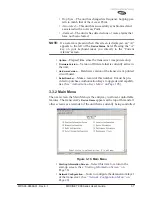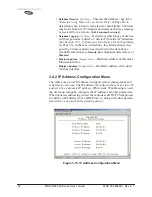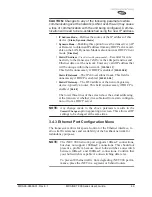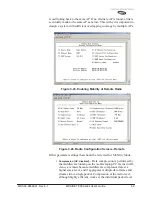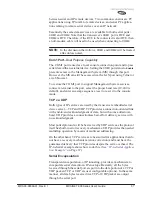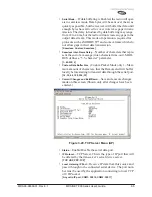
MDS 05-2806A01, Rev. E.1
MDS iNET 900 Series User’s Guide
51
NOTE:
While the transceiver accepts RTS Threshold values below
100, the lowest value that works is 100.
TIP:
Lower the
RTS Threshold
as the number of Remotes or
overall over-the-air traffic increases. Using RTS/CTS is a
trade-off, giving up some throughput in order to prevent
collisions in a busy over-the-air network.
The
RTS Threshold
should be enabled and set with a value
smaller than the
Fragmentation Threshold
described above.
RTS forces the Remotes to request permission from the
AP before sending a packet. The AP sends a CTS control
packet to grant permission to one Remote. All other
Remotes stop transmitting for the specified amount of
time.
•
RSSI Threshold (for alarm)
—Level (dBm) below which the
received signal strength is deemed to have degraded, and a crit-
ical event (alarm) is generated and logged. Under these condi-
tions, the
PWR
lamp flashes, and a trap is sent to the trap
manager if SNMP is enabled and set properly. [
0 to -120; -90
]
•
SNR Threshold (for alarm)
—Value (dB) below which the sig-
nal-to-noise ratio is deemed to have degraded and a critical
event is generated and logged. Under these conditions, the
PWR
lamp flashes, and a trap is sent to the trap manager if SNMP is
enabled and set properly. [
0 to 40; Not Programmed
]
•
RF Hopping Format
—Operation compliant to country-specific
restrictions into the frequency hopping algorithm. This option
must be specified when the order is placed and cannot be mod-
ified in the field by the user. Authorizations at time of publica-
tion:
• Australia: 915–928 MHz band
• Brazil: 902-907.5 and 915-928 MHz bands
• U.S.A. & Canada: 902–928 MHz band
• Chile: 902–928 MHz, selectable hopping, from 1 to 80 chan-
nels
• iNET II: Single-channel selectable from 2 to 79.
NOTE:
Other country-specific configurations may be available.
Check with your factory sales representative for new addi-
tions.
•
Skip Zones
(Editable at AP Only)
—Display of current utilization of
zones. Each zone consists of eight RF channels. In some
instances there may be a part of the spectrum used by another
system, that results in “continuous” or “persistent” interference
to your system. To alleviate this form of interference, the trans-
ceiver may be programmed to “block out” affected portions of
the spectrum using the Skip Zones Menu.
Summary of Contents for iNET 900 Series
Page 10: ...2 MDS iNET 900 Series User s Guide MDS 05 2806A01 Rev E 1 ...
Page 26: ...18 MDS iNET 900 Series User s Guide MDS 05 2806A01 Rev E 1 ...
Page 118: ...110 MDS iNET 900 Series User s Guide MDS 05 2806A01 Rev E 1 ...
Page 120: ...112 MDS iNET 900 Series User s Guide MDS 05 2806A01 Rev E 1 ...
Page 136: ...128 MDS iNET 900 Series User s Guide MDS 05 2806A01 Rev E 1 ...
Page 148: ...140 MDS iNET 900 Series User s Guide MDS 05 2806A01 Rev E 1 ...
Page 150: ...142 MDS iNET 900 Series User s Guide MDS 05 2806A01 Rev E 1 ...
Page 164: ...156 MDS iNET 900 Series User s Guide MDS 05 2806A01 Rev E 1 ...
Page 172: ...164 MDS iNET 900 Series User s Guide MDS 05 2806A01 Rev E 1 ...

